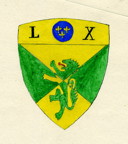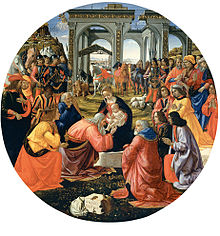Tornabuoni (family)
The Tornabuoni refers to a family of early modern Florence from the Medici sphere of activity . She is best known for her patronage projects, such as the Tornabuoni Chapel in the Santa Maria Novella Church in Florence. The best-known members of the family include the siblings Lucrezia and Giovanni Tornabuoni and Giovanna Tornabuoni .
history
origin
At the end of the 14th century, the Tornabuoni split from their noble tribe - the Tornaquinci. The reason for this split was the desire for political participation. Since members of the aristocracy in the Florentine Trecento were forbidden to take on political offices, Simone Tornabuoni broke away from the noble main branch in 1393 and started a new family. Thus the Tornabuoni originally come from the traditional and powerful noble family of the Tornaquinci - but the Tornabuoni of the 15th century were among the new families, the gente nuova .
Heyday
The Tornabuoni established themselves in the political arena in the first third of the 15th century, beginning with Francesco Tornabuoni, the son of the family founder Simone. In the second half of the 15th century, especially between 1470 and 1490, the highest density of family members can be found in official offices. Overall, the city's archival sources testify to a massive Tornabuoni presence, particularly in the financial sector. The entries at the land registry office contain references to a Florentine warehouse of the Tornabuoni and to trading activities in the textile sector. Membership in the prestigious Arte di Calimala guild , which has been proven since Filippo di Simone joined in April 1396, provides an informative picture of their high social status .
With the siblings Giovanni and Lucrezia Tornabuoni, the two most prominent representatives of the family appeared after the middle of the century. Lucrezia (1425–1482) was an author of hymns and wrote a large number of family letters. She was in lively exchange with the humanist writer Angelo Ambrogini, known as Poliziano , and inspired Luigi Pulci's poem "Morgante". Her fame is primarily due to the fact that she is the mother of Lorenzo de 'Medici , the Magnificent.
Lucrezia's brother Giovanni (1428–1497) achieved reputation and prosperity as the Medici banker. Not only Giovanni's professional and economic success secured the Tornabuoni a social position among the first families of the republic. Above all, his patronage practice is to be understood as an expression of the high ambitions of the Tornabuoni to participate in the closest circle of political decision-makers. Giovanni is the first Tornabuoni who was demonstrably active as a founder.
Patronage projects
For the sacred space, Giovanni Tornabuoni commissioned the Tornabuoni Chapel (1486–1490) in the choir of the Church of Santa Maria Novella with wall frescoes, altarpieces, narrative window decorations, furniture and liturgical equipment. In addition, he arranged for the decoration of a memorial chapel in honor of his late wife Francesca Pittis in Santa Maria sopra Minerva in Rome (after 1477). In the secular area, he had a city palace and two country villas built. One of the country houses was Villa Macerelli in Careggi (today's Villa Lemmi), the other, called Le Bracche, near Castello. The construction of the Palazzo (today Palazzo Corsi) in today's Via Tornabuoni in the Santa Maria Novella district was completed in 1469. However, drastic renovation measures in the 1880s have greatly changed the original state. A surviving inventory from 1498 shows that the interior of the Palazzo Tornabuoni was particularly splendid compared to other Quattrocento palaces.
Giovanni's son Lorenzo Tornabuoni, a close confidante of Piero di Lorenzo de 'Medici and husband of Giovanna Tornabuoni , continued the patronage practice of his father with the planning of a family chapel in the Cistercian church of Cestello, the furnishing of his wedding chambers in the Palazzo Tornabuoni and numerous panel paintings for private devotion impressive way. The paintings commissioned by Lorenzo Tornabuoni include, among others, Domenico Ghirlandaio's famous Madrid portrait of Giovanna Tornabuoni and a tondo with the three-king motif, also by Ghirlandaio. The Cappella Tornabuoni in Cestello was intended as a memorial site for Lorenzo's wife Giovanna, who died in 1488, and was consecrated in June 1491.
Lorenzo's portrait was recorded at least four times: in two frescoes of Ghirlandaios - at the age of thirteen in the Sistine Chapel in Rome and as a young adult in the Tornabuoni Chapel -, on a portrait medal by Niccolò Fiorentino and in Sandro Botticelli's fresco in the Tornabuoni country house in Careggi, the is now in the Louvre .
swell
Historical research can fall back on a large number of images and text sources that are still preserved today. The surviving text sources on the history of the Tornabuoni are varied: contemporary chronicles, account books, notarial certification, household inventories, church archival documents, private correspondence and literary texts. However, there is no evidence of a family chronicle or trading books of the Tornabuoni.
Only a list of key words from the last quarter of the 14th century is preserved in the Biblioteca Riccardiana in Florence, anonymously and not published. The family is briefly mentioned in De illustratione urbis Florentiae , an epic by the humanist poet Ugolino Verino (1438–1516) about Florence from the 1480s and in the works of Francesco Guicciardini and Niccolò Machiavelli . The Notarile Antecosimiano in the Florentine Archivio di Stato provides information on the economic situation of Tornabuoni.
literature
The Tornabuoni family has so far been dealt with in a first essay by Guido Pampaloni from 1968 and more comprehensively in the monograph Eleonora Plebanis from 2002. Gert Jan van der Sman recently added to his study of the life and works of art around Giovanna degli Albizzi and Lorenzo Tornabuoni the source situation around newly published material and provided the first coherent account of the generation after Giovanni. Merseburger's work from 2018 deals explicitly with the portraits of the Tornabuoni members.
- Ugolino Verino: De Illustratione Urbis Florentiae. 3 volumes, Paris 1790 (1st edition 1583).
- Raymond de Roover : The Rise and Decline of the Medici Bank, 1397-1494. Beard Group Inc., Cambridge 1963, ISBN 978-1893122321 .
- Guido Pampaloni: Tornaquinci, poi Tornabuoni, fino ai primi del cinquecento. In: Archivio Storico Italiano, No. 126 (1968), pp. 331-362.
- Alison Lynx: Cestello. A Cistercian Church of the Florentine Renaissance. Garland Pub. Co., Diss., New York / London 1977.
- Sheila McClure Ross: The Redecoration of Santa Maria Novella's "Cappella Maggiore". University of California, Diss., Berkeley 1983.
- Patricia Simons: Portraiture and Patronage in Quattrocento Florence with Special Reference to the Tornaquinci and Their Chapel in S. Maria Novella . University of Melbourne, Diss., 2 Vols., Melbourne 1985 online .
- John Kent Lydecker: The Domestic Setting of the Arts in Renaissance Florence. Johns Hopkins University, Diss., Baltimore 1987.
- Francesco Gurrieri: Il Palazzo Tornabuoni Corsi. Sede a Firenze della Banca Commerciale Italiana. Terra Ferma Edizioni, Florence 1992, ISBN 978-8887760873 .
- Patrizia Salvadori (ed.): Lucrezia Tornabuoni: Lettere. Olschki, Florence 1993, ISBN 978-8822241344 .
- Josef Schmid: "et pro remedio animae et pro memoria". Civil repraesentatio in the Cappella Tornabuoni in S. Maria Novella. Deutscher Kunstverlag, Diss., Munich / Berlin 2002, ISBN 978-3-422-06371-6 .
- Susanne Kress: "The camera di Lorenzo, bella" in the Palazzo Tornabuoni. Reconstruction and artistic furnishing of a Florentine wedding room of the late Quattrocento. In: Michael Rohlmann (Ed.): Artistic construction of identity in the Florence of the Renaissance. VDG Weimar, Weimar 2003, ISBN 978-3897393714 , pp. 245-285.
- Eleonora Plebani: I Tornabuoni. Una famiglia fiorentina alla fine del Medioevo. FrancoAngeli, Milan 2002, ISBN 9788846441799 .
- Gert Jan van der Sman: Lorenzo and Giovanna. Timeless Art and Fleeting Lives in Renaissance Florence. Mandragora, Florence 2010, ISBN 9788874611287 .
- Maria K. DePrano: The Art Works Honoring Giovanna degli Albizzi: Lorenzo Tornabuoni, the Humanism of Poliziano, and the Art of Niccolò Fiorentino and Domenico Ghirlandaio. University of California, Diss., Los Angeles 2004.
- Brenda Preyer: Palazzo Tornabuoni in 1498. A Palace “in Progress” and its interior arrangement. In: Mitteilungen des Kunsthistorisches Institut in Florenz 57, Heft 1 (2015), pp. 43–63.
- Maria Merseburger: Painted drapery in the Florentine Quattrocento. Ghirlandaios Tornabuoni Chapel. Humboldt-Univ., Diss., Berlin 2018 online .
Web links
See also
Individual evidence
- ↑ Plebani 2002, pp. 29-50.
- ↑ Plebani 2002, p. 183, in detail cf. Pp. 85-193; Table with all official offices of Tornabuoni members p. 192f.
- ↑ Florentine State Archive Archivio di Stato di Firenze: ASFi, Catasto 922, fol. 152r, quoted from Plebani 2002, pp. 228–232, note 119.
- ↑ Florentine State Archive Archivio di Stato di Firenze: ASFi, Manoscritti 542, fol. 77v, quoted from Plebani 2002, p. 233, note 122.
- ↑ Lucrezia Tornabuoni's writings have so far only been published in parts. The most comprehensive compilation of her works in: Salvadori 1993.
- ↑ Information on Giovanni Tornabuoni's life and work is provided by Roover 1963, pp. 218–244; Plebani 2002 and Merseburger 2018, especially pp. 74–81.
- ↑ Simons 1985, Vol. 1, pp. 170ff.
- ↑ To Palazzo Tornabuoni most recently Preyer 2015; previously Gurrieri 1992.
- ↑ The inventory of the Tornabuoni is in the Florentine State Archives Archivio di Stato di Firenze: ASFi, Magistrato dei Pupilli avanti il Principato 181. The inventory of the Tornabuoni property is divided into the Villa Macerelli in Careggi (fol. 141r – 144r), the inventory of the Villa Le Brache in Castello (fol. 144–146r) and finally the possessions in the palazzo in the city (fol. 146v – 150r). The inventory has so far been published in excerpts. With a focus on the decoration program for the rooms by Lorenzo Tornabuoni cf. Sman 2010, pp. 66-89 and Kress 2003, pp. 245-285. Excerpts from the inventory also at Merseburger 2018; Lydecker 1987 and McClure Ross 1983.
- ↑ The church is currently called Santa Maria Maddalena de 'Pazzi and is located in the northeastern part of the city of Florence, in today's Borgo Pinti. Starting from the facade, the Tornabuoni Chapel is the third chapel on the left side of the central nave; see. for an overview, DePrano 2004, pp. 196-204; in detail Luchs 1977, pp. 83-85.
- ↑ A copy of the portrait medal on Lorenzo Tornabuoni is preserved in Washington: Attributed to Niccolò Fiorentino: Portrait medal on Lorenzo Tornabuoni , around 1485, bronze, 7.81 cm, National Gallery of Art Washington DC, inv. 1957.14.890.a
- ^ Biblioteca Riccardiana di Firenze, Cod. Riccardiano 1885, fols. 1r – 6r, cit. n. Plebani 2002, p. 23f.
- ↑ Verino 1790, Volume 3, p. 32.
- ↑ On the Notarile Antecosimiano and the mentions in Guicciardini and Machiavelli cf. Plebani 2002, pp. 24-28.







